Warhammer 40,000: Chaos Gate – Daemonhunters (good lord that’s an unwieldy name) is a game I’m convinced I brought into existence by force of will alone. It was announced as part of a big Warhammer videogames event around this time last year, and my friends were having fun guessing what each game trailer was supposed to be before the title card flashed up. But me? I was just guessing “Chaos Gate 2!” on every single one, mostly because the idea was so absurd — who would make a semi-sequel to a shonky 40k XCOM clone from 24 years ago that barely anyone played at the time? — but also secretly because Chaos Gate is one of the two games from the late 90s glut of 40k titles that I do actually want a reboot/sequel to1. And this meant I damn near fell off my chair when the words “CHAOS GATE” appeared at the end of the Daemonhunters teaser, like the universe had finally got tired of my constant complaining and spontaneously reshaped itself into a place where Chaos Gate 2 could exist in a futile attempt to get me to shut up, and in fact it left me questioning the nature of my reality for several days afterwards — after all, if Chaos Gate 2 was actually happening then nothing is impossible.
Fast forward a year and Chaos Gate 2 (hereafter referred to as Daemonhunters) has actually been released, and I’m somewhat torn on the reality of having my wish granted. These reboots normally have fairly binary outcomes: they either turn out to either be worthy updates of an old classic (Age of Empires 2 Definitive Edition, Command & Conquer Remastered) or they’re mediocre cash-ins with very few ideas that are hoping to leverage the name in order to boost sales (the Syndicate FPS and the Thief reboot), but Daemonhunters is neither. In part that’s because “classic” is the last word most people would use to describe Chaos Gate and I doubt very many of them would recognise the name, either, but mostly it is because Daemonhunters opts to take nothing from the 1998 original aside from the name — it charts its own path, for better or worse. Usually it somehow manages to be both at the same time.
Ah, but if you’ve watched a video of Daemonhunters in action you’ll probably be raising an eyebrow at that last statement. Chaos Gate 1998 was the original X-COM with a 40k skin pasted over the top – it had a static, scripted campaign missions rather than a geoscape layer equivalent, but otherwise a lot of the gameplay concepts were a 1:1 match. Similarly, at first glance Daemonhunters looks exactly like modern XCOM with a modern 40k skin pasted over the top. Surely that same core concept at least provides some sort of common through-line, even if Daemonhunters didn’t continue the fine Chaos Gate tradition of crashing every time you tried to move a Predator tank?
Now that I’ve finished the campaign, though, the thing I find most fascinating about Daemonhunters is how much like XCOM it isn’t. This is a strange thing to say considering it has many of the same concepts like High/Low Cover and Overwatch, and the UI for the tactical battles is damn near identical. Your Space Marines are surprisingly agile for giants in heavy suits of power armour, leaping across gaps and clambering up walls just like the soldiers from nu-XCOM. Even the strategy layer feels like a copy-paste job at times, down to having the Engineer, Scientist and Commander characters in your base that you can go around and talk to; it’s just that instead of Vahlen you get an Inquisitor, and instead of Shen you get a Tech-Priest, and instead of Bradford you get Mr Potato Head. And even Daemonhunters itself seems convinced that it is XCOM, as it spends most of the tutorial teaching you about the importance of taking cover and Overwatch. True, at the time this was relevant information — for about two hours, after which Daemonhunters turned into something else entirely.
Daemonhunters has you taking command of an elite Grey Knights strike force tasked with stopping a daemonic plague that’s threatening to consume an entire sector of the galaxy. The Grey Knights might look like the generic Space Marine poster boys fronting just about every other 40k product2, but there is one important difference: where the Space Marines are genetically-engineered superhumans, the Grey Knights are even more genetically-engineered super-duper humans. All of them have psychic powers — which is 40k-speak for “can cast magic spells” — and the entire point of the Grey Knights as an organisation is to use those powers to fight and destroy Chaos daemons, which are exactly what they sound like: hellish monstrosities summoned from an alternate dimension to corrupt and enslave humanity.
In game terms this means you fly your Grey Knights strike cruiser around the sector playing whack-a-mole with plague outbreaks, and every time you reach a star system that’s under threat you can purge the infection by deploying a squad of four Knights into a turn-based tactical battle to eliminate any Chaos forces present there. Success in the tactical battle segment will reduce the infection level of that system by one. Failure — or the far more common outcome of not being able to get to an infected system in time — raises the infection level by between one and three. Once a system’s infection rating reaches five I assume bad things happen as this is the nominal cap, with the infection spreading to neighbouring star systems if the cap is exceeded. You’ll note the word “assume” in that sentence, though — in practice the Daemonhunters strategy layer is easy enough to deal with that I never had a planet get to a level five infection rating, and in fact I don’t actually know what the lose condition for the Daemonhunters campaign is. Presumably you get a Game Over screen if too many planets are consumed by the plague, but on Standard difficulty at least this was never remotely a possibility.
This I thought was a bit of a shame, because while Daemonhunters also shares XCOM’s habit of shamelessly stealing its mechanics from popular boardgames it’s at least stolen them from a decent one; the Daemonhunters strategy layer is essentially a 1:1 copy of Pandemic with a few XCOM-y bits like research and ship upgrades thrown in on top, but for whatever reason it doesn’t choose to bring across the Infection deck that relentlessly pressures Pandemic players, instead preferring the comparatively more sedate XCOM approach of randomly spawning three missions and making the player pick which one they want to deal with. This is far easier to manage as it’s always pretty obvious what the “correct” choice is (hint: it’s the one that adds 3 infection pips to a system), and the gap between infection events is long enough that the game will end long before you get to the point of having to launch your Exterminatus torpedoes at a planet that’s beyond saving. There’s no economy to speak of here, either; you collect one currency called Servitors to upgrade your ship and another currency called Requisition to buy new Knights and equipment, but 95% of these will come from mission rewards rather than being gathered on the strategy layer and so you just spend what you’ve got when you’ve got it and otherwise don’t worry about it too much. And while Daemonhunters does have research, the vast majority of the tech tree is based around unlocking new Strategem cards — one-shot powerups that can be played during missions to give yourself an edge — instead of new guns or armour, and because you can only play 2-3 of these per mission research only ever feels like a bolt-on rather than something integral to the flow of the game.
Most of the good stuff Daemonhunters is doing happens on the tactical layer, then, which I found surprising because to start with this looked like the least interesting part of the game by a long way. Another thing Daemonhunters shares with XCOM is its inverse difficulty curve, where the game is paradoxically much harder at the beginning than it is at the end because you have a squad full of rookies who can’t do anything besides move and shoot. Because this is a 40k game there’s a much bigger emphasis on melee combat — most of your Knights are carrying some gigantic two-handed sword or halberd as their primary weapon, with a comparatively tiny machine gun stuck to their forearm — but the difference between shooting somebody and running up to them and hitting them with a basic melee attack is usually just a single point of damage. Both of them are the least effective ways to kill an enemy in the entire game, and for those first two hours they’re all you have. Enemy pod sizes are much larger compared to XCOM, with a pod marker vomiting forth 8-9 baddies once the fog of war shrouding it is removed, and unless you have some grenades left you’re forced to kill each of these enemies individually.
Thanks to this the start of the Daemonhunters campaign can feel overwhelming and drastically unfair at times, especially since yet another thing that’s been inherited from XCOM — which really shouldn’t have been, given the fiction underpinning them — is that your Knights are extremely fragile. They have a bit more resilience to hitting 0HP than an XCOM soldier does thanks to the Critical Wounds system, which functions essentially as extra lives, but I think that’s a band-aid applied to the wrong place since I never saw them get that low. The problem here is that, despite the Grey Knights ostensibly being the most elite warriors humanity has to offer, hulking giants with instantly-clotting blood, multiple backup organs in case the originals get taken out, and encased in gigantic suits of armour that can shrug off anti-tank weaponry, Daemonhunters still takes the XCOM approach to wounded soldier recovery times. What this means is that you have a Knight wearing Terminator armour — described in the fluff as “the toughest personal armour in the galaxy” — who gets shot by a Chaos cultist wielding an autogun, which is equivalent to a modern-day AK-47. The autogun takes off about 10% of the Knight’s HP. You think this is no big deal, turn the cultist into pulp with your storm bolter, and finish the mission with no further mishaps. Then the end mission screen pops up and it turns out that this one autogun hit has inflicted “light wounds” which will take a whopping 24 days to recover from. Unlike XCOM you can still send wounded Knights on missions so this isn’t a total blocker, but they’ll have an HP penalty and a higher chance of being pushed into a Critical Wounds state, so the extremely heavy implication is that you should not be doing this.
Because the penalty for being shot once is having to spend a month in the hospital, and because your starting weapons and abilities are complete garbage, and because the start of the game is the point where the odds are most stacked against you (pods with late-game enemies have just 3-4 baddies), and because the tutorial focuses on all of the wrong things, the initial impression of Daemonhunters is that it’s just a punishing, overtuned XCOM clone. I imagine this is where a lot of people will fall out of the game, unwilling to push through the initial wall of bullshit to see if there’s anything worthwhile beyond it, and that would be a shame because even at this early stage there are some hints that somebody has given a little more thought to the design of the tactical layer than the phrase “XCOM clone” implies. Despite the many, many superficial similarities, there are three immediately obvious changes Daemonhunters makes to the XCOM formula, and in my opinion they’re very much changes for the better:
- Entirely deterministic damage. Every single ranged attack and melee attack in Daemonhunters will hit an enemy (or your Knights) 100% of the time. Both melee and ranged attack damage is affected by buffs and debuffs, while ranged attacks suffer damage dropoff outside of optimum range and they can also have their damage blocked by cover — half cover blocks half of the incoming damage, full cover blocks all of it. All of this is surfaced to you before you confirm the attack, though — you always know exactly how much damage an attack will do before it connects, allowing you to plan out your turns with much more precision.
- Instead of the choice between running or moving + shooting that XCOM offered its squaddies, Daemonhunters gives its Knights 3 Action Points per turn which can be used to move or shoot or use a utility item. This potentially allows your four Knights to attack a total of 12 times per turn (which is one reason Daemonhunters is so gung-ho about throwing hordes of enemies at you) and the switch to Action Points in general allows you a greater degree of flexibility in how you plan your turns.
- Overwatch has been nerfed to the point where it is almost totally useless.
This one deserves a full paragraph instead of the world’s longest bullet point, because the way Daemonhunters handles Overwatch is another thing that seems absurd when you first see it. Instead of being an abstract state where a soldier shoots at the first thing that blunders into their line of sight no matter where it is, Daemonhunters Overwatch needs to be set up over a discrete firing arc and only things that walk into the Overwatch area of effect will trigger an Overwatch attack. On its own this is not the wildest concept in the world (Phantom Doctrine did something very similar five years ago) but the nerf comes in the form of making the Overwatch firing arc so short that it’s outranged by every single ranged enemy in the game; if you set up a Knight in Overwatch they can just find a good firing position outside of your Overwatch range and shoot you in the face. This feels stupid and arbitrary to start with — why do all of my guns have the same approximate range as a water pistol? — but the more I played the game the more it made sense; Overwatch is now a very specific counter to hordes of weak melee enemies rather than the default state in which you end your turn.
No, instead of cowering behind cover with Overwatch turned on waiting for enemies to come to you — which, let’s face it, does look a bit ridiculous when it’s an 8-foot tall supersoldier doing it — Daemonhunters instead wants you to be aggressive and mobile, using those Action Points and your enhanced ability to plan out a turn to obliterate enemy groups before they get the opportunity to fire off a weak attack that very slightly scratches somebody’s armour and somehow puts them in traction for weeks. At the start of the game this is a big ask because you don’t have the tools for it, and the tutorial has emphasised all of the wrong things, tricking you into thinking that cover and Overwatch are actually going to be important. But if you stick with it through this stodgy beginning for a couple of hours you’ll find that, while the Grey Knights may be the second most boring chapter of Space Marines in existence and terrible protagonists in a narrative sense, there’s actually a good reason for why they’ve been picked to headline this game: what they also are, and what Daemonhunters communicates very effectively in its gameplay, are a collection of the biggest psychic trolls in the entire galaxy.
Consider the XCOM approach to activating a pod (XCOM-speak for “running into a patrol”) of enemies. The enemies get a free scramble move to get into impregnable cover positions, and your options from there are fairly limited; you either destroy their cover with explosives so that you can shoot them, or else you flank them for a better shot — which risks activating other pods, and which might not work anyway because your attacks always have a chance of missing. You always feel like you’re on the back foot in XCOM and you’ll almost never succeed in wiping out an enemy group before they can take a few potshots at you, because the game has its thumb on the scales to make sure that you can’t.
Now, Daemonhunters has copied quite a lot from XCOM and it also copies pod activation — which I was extremely annoyed about at first, for all that Daemonhunters does make the improvement of marking pods in the fog of war so that you’re much less likely to activate two at once; I can’t believe that it’s been a full decade since the XCOM reboot and I’m still having to manage pod activation in tactical strategy games. Anyway, just like in XCOM enemies in pods that you activate get a free scramble move to get into advantageous cover positions that make them difficult to shoot. But in Daemonhunters this doesn’t actually matter because you can just teleport some or all of your squad behind the enemy cover positions and then start beating the shit out of them with those big swords you’re carrying around. Or you can cast a big bonus damage debuff and then get one of your guys to zip around doing teleport strikes like he’s Nightcrawler from the opening of X-Men 2. Or you can just summon a big psychic storm to instantly mulch anything weaker than a Plague Marine, and then finish off any survivors with Power Word: Brain Aneurysm. Because your psychic abilities always hit and do guaranteed damage the problem space has moved away from the qualified risk management of XCOM towards the turn sequencing of something like Into the Breach; the enemy pod has an aggregate health of value of X, and you are trying to structure your ability use so that your squad’s total damage output for that turn is a value greater than X. And if you can do this all of the enemies will be dead before they get a chance to fire their weapons.
I’ll admit that crushing everything with brain powers is not quite how I imagined a tactical strategy game starring the Space Marines playing out, but it’s not an unwelcome outcome. As you level up your squad and unlock more abilities and equipment the battles become more and more lopsided despite the introduction of bigger, tougher enemy types, until you discover an enemy that looks like a big scary Chaos Dreadnought (I lost track of modern Warhammer 40k unit names a very long time ago) and instead of dispersing the squad and focus firing it down you instead send in one of your particularly OP Knights to 1v1 it in a melee brawl just for funsies — and it actually works. But despite the threat factor of the Chaos hordes dropping to basically zero around the halfway point of the campaign, figuring out exactly how you’re going to kill them in a single turn remains an engrossing problem for around 80% of the game; I’ve been a sucker for anything that lets me do this kind of turn sequencing for a long time now, and Daemonhunters reminded me quite pleasantly of things like Druidstone and Mechanicus.
(Well, obviously it reminded me of Mechanicus since they’re both tactical strategy games set in the Warhammer 40k universe. But we’ll get onto the less favourable fluff-related bits of that comparison in a moment; if you look past the branding I thought they both had a very similar take on deterministic outcomes and turn sequencing being the core of the game.)
That’s quite a qualified endorsement. Still, despite looking like an out-and-out XCOM clone to start with I was pleased to discover that Daemonhunters had in fact learned quite a lot from the modern crop of XCOM successors; the balancing is arguably a little too out of whack as the sequence of climactic bossfights that the campaign finished with were just as much of a one-sided joke as crushing the Level 1 Chaos Cultists was by this point, and I would say that if you are the sort of person who plays these games regularly then you should play your first campaign on Hard rather than Normal. I would also say I’d try that for my second campaign, but despite enjoying the bulk of its campaign for the gameplay I still don’t think I’ll ever boot up Daemonhunters again after I’ve finished writing this review, and the main reason for this is that Daemonhunters is a crap 40k game.
Yes, it’s time to address the elephant in the room: if we’re talking about 40k strategy games, then there’s no getting around the fact that there was a perfectly decent one released about four years ago called Mechanicus. In terms of gameplay Mechanicus was moderately good rather than awesomely great (although I understand they did actually go back and fix the worst of the wonky balancing problems I talked about in my review) and about on par with Daemonhunters; however, it was a much better 40k game for a number of reasons:
- Instead of the Blandmarines Mechanicus starred the Tech-Priests of Mars, a bunch of weird techno-zealots who start the game looking relatively human and and end it as a collection of mechanical monstrosities as you replace all of their human bits with cybernetic augmentations.
- Mechanicus correctly identified the concept of Cover as having no place in a 40k strategy game and removed it completely. Instead of taking cover you summon disposable cannon fodder troops to take the hits for you. Which is the most 40k thing a 40k videogame has ever done.
- Daemonhunters has a soundtrack that’s trying to channel 40k but which ends up sounding so generically medieval that you could paste it into any fantasy RPG released in the last twenty years and I wouldn’t be able to tell the difference. The Mechanicus soundtrack, on the other hand, is an astounding fusion of techno, dubstep and pipe organs which perfectly encapsulates the weird mix of technology and religion that 40k (and the Mechanicus in particular) represents.
- The story underpinning Mechanicus wasn’t the best, but it was at least treated fairly disposably and the game didn’t dwell on it much outside of post-mission voiceovers, preferring instead to rely on presentation and atmosphere rather than the quality of its writing. Daemonhunters… does not do this. And it’s a big mistake.
It’s not even that the Daemonhunters story is particularly bad. It’s suffering from the handicap of being modern 40k fiction and thus naturally inferior because modern 40k fiction is obsessed with demythologising everything and making it far less cool and far more mundane by explaining it all in painstaking detail; nevertheless, they’ve got one of the better Black Library3 writers in to do the story and it’s mostly competently written by videogame standards, and especially by 40k videogame standards. The problem is that the developers seem convinced that the story is the point of the game, rather than the excuse for it happening, and have sunk a huge amount of resources into this thing to the point of having paid Andy Serkis some money to take a break from dressing up in a motion capture suit to come and shout at you every 60 in-game days. It feels like every other mission there’s a cutscene that takes forever to get to the point, with a full one-minute panning shot of your Inquisitor sitting in a chair before anyone says anything, and when they do finally talk the actual amount of information imparted is laughable, the absolute epitome of a meeting that could have been an email. (Or an in-mission voiceover, but Daemonhunters also screws those up by making them unskippable.) Mostly what you’re subjected to is the Inquisitor and the Bradford-analogue character having constant, childish arguments that very quickly became insufferable; I don’t know why they felt the need to include this stuff so often, or why it went on for so long, when the content of most of the cutscenes is yet another round of Bradford accusing the Inquisitor of heresy and the Inquisitor accusing Bradford of having a small dick4. There are big structural problems with the campaign — the aforementioned balancing issues, and campaign events that reminded me unpleasantly of Oregon Trail, and also there are only three mission types in the entire game — but the story is the number one reason I won’t replay it, because I don’t think I can stomach sitting through all of that again.
So, given that gameplay-wise they exist in a space that is very similar, and given that Mechanicus is much better at the actually-leveraging-the-40k-license bit, if in the future I ever get the hankering to play a tactical strategy game set in the Warhammer 40,000 universe I’m going to install Mechanicus instead of Daemonhunters every time. Daemonhunters itself is surprisingly solid, but — and this is an observation I also made about Necromunda last year — I think I would have been happier with it if it wasn’t a Warhammer 40k game starring the Grey Knights. Daemonhunters might leverage their psychic powers well but it tosses the entire rest of the concept of “being Space Marines” out of the window (you wouldn’t see any of these boys cowering behind pipes and rusty metal in case they get shot) and I think it should have instead gone for a theme that fit over its core gameplay goals a little bit better. It probably would have sold fewer copies, though, and I suppose if we have to have two of these things then it can at least be considered a success for Daemonhunters that it won’t be remembered as “the shit one”.
- The other is a Final Liberation reboot complete with weirdly melancholic guitar soundtrack. ↩
- Which is an automatic black mark against the game, because the most interesting 40k games to date have been the ones which didn’t star the Space Marines. ↩
- The Black Library is Games Workshop’s in-house book publishing arm, which largely functions as a firehose of some of the most terribly-written fanfiction-grade tripe I’ve ever read in my life. ↩
- Perhaps not using those exact words, but this is basically the subtext of pretty much everything she says to him. ↩

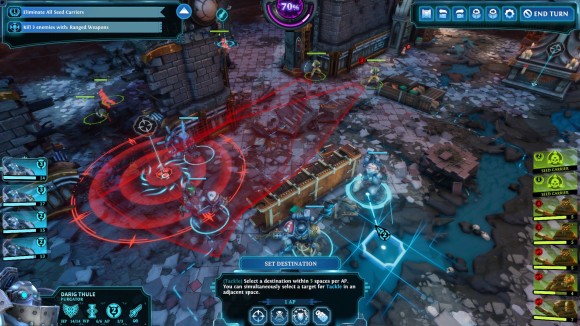
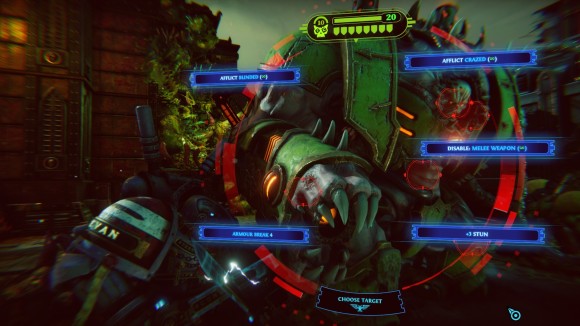
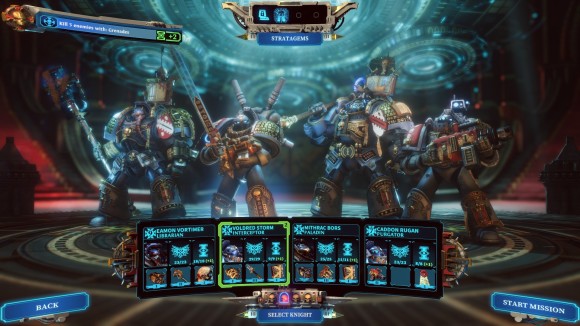
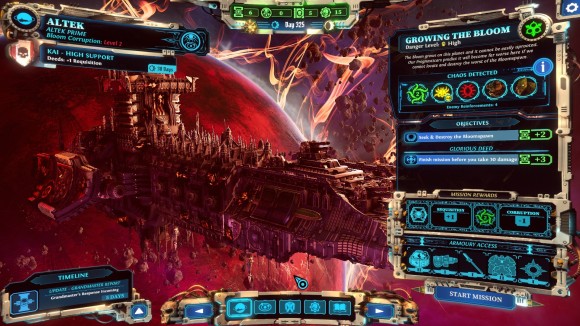
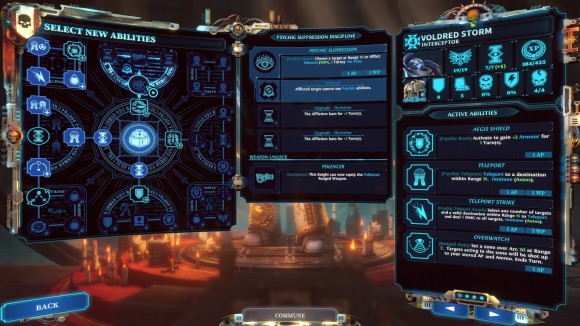
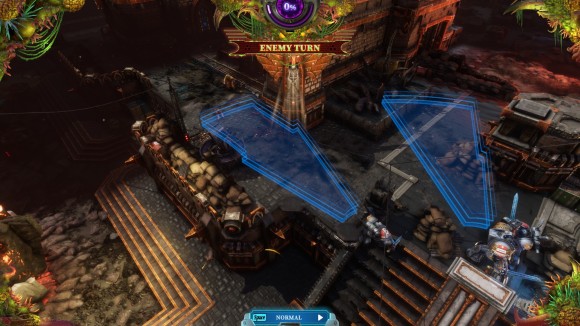
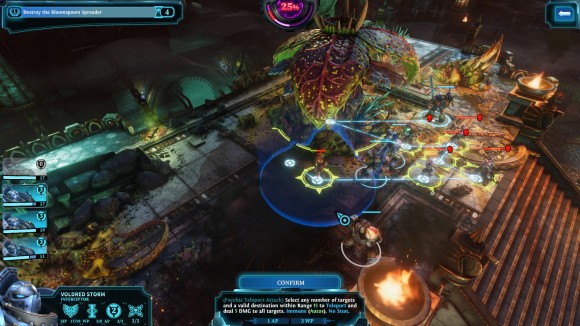
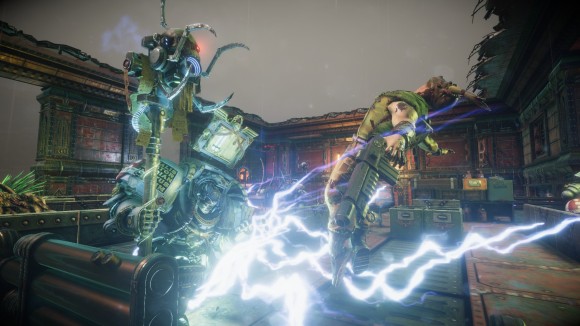
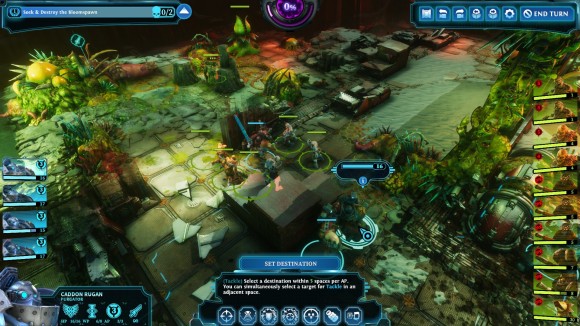
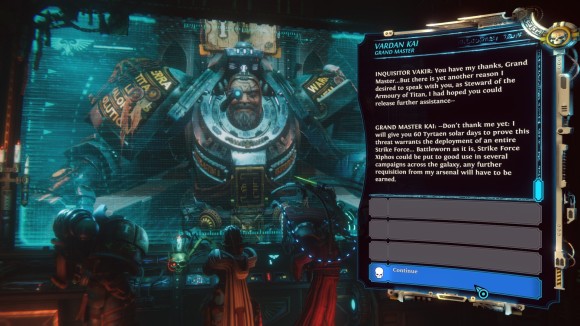
Curious – If one is blissfully ignorant of Warhammer universe, lore, games, media – everything … what would be a good place to start? Battlefleet Armada? Mechanicus? Something else? Thx!
… what would be a good place to start? Battlefleet Armada? Mechanicus? Something else? Thx!
Probably the best game in the Warhammer 40k universe is still “Warhammer 40,000: Dawn of War II”
I’ll start with that if I were you.
Kudos to mentioning Final Liberation at the end, I too would very much like a remaster of that. The joys of 90′s 40k games.
Just finished this game and I agree on just about all your comments. I’d add a couple of things:
1) the game does a few wonderful quality of life improvements, most prominently the fact that when you trigger a pod (without any other enemies already engaged) your knights action points all regenerate to full, so you don’t have to inch forward trying to make sure you only trigger a pod at the beginning of your turn, which really helps in-mission pacing.
2) My experience, at least, was that the game became a grind about 25 hours in, when it kept giving you the same 3 missions and very little else for another 20 hours. I really enjoyed the gameplay, and unlocking new knight abilities, but I do wish the designers had sped up the main plot.